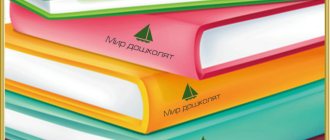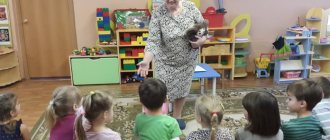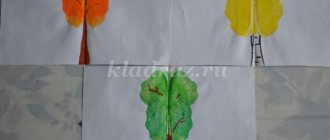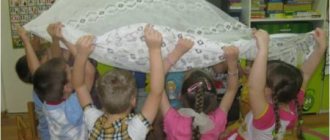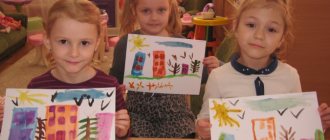Card index of conversations with children of the middle group about healthy lifestyle
Card index of conversations with children of the middle group about a healthy lifestyle
Conversation “Cleanliness is the key to health”
Hello, dear guys! Let's talk about cleanliness today.
Do you think cleanliness and health are related?
Right! Connected. No wonder they say: “Cleanliness is the key to health.”
This means that if a person is clean and tidy, cleanliness reigns around him, he follows one of the important rules of life that allows him to be healthy.
Imagine an unkempt, slovenly little boy, Petya. He rarely washes his hands with soap and does not like to cut his nails, so dark streaks of dirt have formed under his nails. Petya forgets to wash his hands before eating, after using the toilet, after playing with his beloved dog.
Would you like to be friends with this boy?
A huge number of harmful microbes accumulate on your hands, which can cause dangerous infectious diseases. Do you remember what these diseases are called? "Diseases of dirty hands." These include jaundice and dysentery.
On the fur of animals - dogs, cats - there are always tiny, invisible worm eggs. They get on the skin of the hands of a person who strokes their pets, and if you don’t wash your hands afterwards, then with food, worm eggs can end up in your stomach and cause helminthiasis.
Let's remember together all the cases when you need to wash your hands with soap.
Right! When you come home from kindergarten, from a walk, from a store, from a clinic.
Hands should be washed before and after eating.
You should definitely wash your hands thoroughly with soap after you have played with a cat or dog, hamster, parrot, or other animals.
Don't forget to wash your hands after using the toilet too!
Cut your nails often. Nails should be rounded, short, and most importantly, there should be no dirt under them!
Therefore, when you wash your hands with soap, carefully clean your nails with a brush, removing dirt from under your nails.
In the evening before going to bed, be sure to wash your feet with warm water and then pour cool water over them. This is, firstly, good conditioning, and secondly, it is an excellent remedy for helping you fall asleep quickly. But deep, restful sleep is an indispensable condition for good health.
I don't think any of you need reminding that your clothes should be neat and clean.
Tell us how you clean your room or your children's corner.
Right! Wipe off the dust with a soft cloth, carefully place books and toys on the shelf. And mother or grandmother cleans carpets and upholstered furniture with a vacuum cleaner.
Why are they doing that?
Right! To remove particles of dust and dirt. After all, house dust is very harmful! It can cause red eyes, sneezing, runny nose, etc. allergies.
Card index of didactic games on the formation of a healthy lifestyle
Topic: “Child and health”
Put the pictures in order
Goal: systematize
children’s ideas about health and a healthy lifestyle, develop speech, attention, memory.
Material: pictures
depicting moments of the daily routine
Progress of the game:
The teacher says that the wizard Confusion has mixed up the pictures of the daily routine, and suggests putting the pictures in order.
The teacher summarizes the children's statements.
Every morning, to be healthy, we start with exercise.
In order to grow strong, dexterous and brave, we do exercises every morning.
The teacher invites everyone to remember their favorite exercise, show it to everyone and do it together.
My day
Target:
talk about your daily routine; learn to explain and prove your point of view; learn to find violations of patterns in a sequential series.
Equipment:
3-4 sets of cards with images of different regime moments.
Progress of the game
: The cards must be placed sequentially, in accordance with the regime (from getting up in the morning to going to bed in the evening), explain to the children why the cards should be laid out this way and not otherwise.
Option 1.
Competition “Who can lay out a row faster?”
Option2.
“Continue the row.” The teacher begins to lay out the sequence, and the child continues.
Option3.
“Correct the mistake.” The teacher lays out the entire sequence of cards, breaking it in one or more places, the children find and correct the mistakes.
What is good, what is bad
Target:
introduce children to the rules of personal hygiene and proper, careful attitude towards their health; develop children's speech, attention, and memory.
Material:
fields divided into squares, in the center of the field there is a negative and positive picture, pictures with different situations.
Progress of the game:
Option 1
Children are given fields; a negative or positive picture is depicted in the center of the field. Children are invited to play lotto, showing and accompanying their actions with explanations - “what is good and what is bad”
2nd option.
Showing pictures can be accompanied by children's motor activity. For example, children react to positive pictures by jumping, and when shown a negative picture they sit on the floor.
What does the heart love?
Didactic task:
instill the habit of a healthy lifestyle, broaden children’s horizons on the prevention of heart disease.
Game rules:
You need to name the type of product or type of activity that is good for the heart.
Game actions:
naming words and connecting parts of the heart into a whole.
Progress of the game:
The teacher asks the children to name types of foods and activities that are good for the heart. Each named word is a part of the heart. Gradually, as children name words, a whole heart is formed. Number of players 8-10 people.
This game can be carried out as part of a lesson on cognitive development, or in the free activity of children, as an independent game.
The morning begins...
Didactic task:
to accustom children to following a daily routine, to consolidate activities carried out at different times of the day.
Game rules:
It is necessary to name the activities carried out in the morning, afternoon, evening, and night.
Game actions:
choosing pictures and naming activities corresponding to morning, afternoon, evening and night.
Progress of the game:
The teacher invites the children to choose a picture of the time of day and name the corresponding activities that need to be carried out at this time of day and arrange the cards in the sequence in which they should be performed. Number of players 8-10 people.
This game can be carried out as part of a lesson on cognitive development, or in the free activity of children, as an independent game.
Health with indoor plants
Didactic task:
consolidate children's knowledge about indoor plants, their names and beneficial properties.
Game rules:
You need to choose from a number of pictures pictures of indoor plants, name them and list their beneficial properties.
Game actions:
naming the plant and determining its usefulness.
Progress of the game:
The teacher invites the children to choose inverted pictures one by one. Having examined the image in the picture, the child needs to name the houseplant and list its beneficial properties. After completing the task, the child receives a chip. The one with the most chips wins. Number of players 8-10 people.
This game can be carried out as part of a lesson on cognitive development, or in the free activity of children, as an independent game.
Topic: “Healthy Products”
Wonderful pouch
Target:
clarify the names of fruits and vegetables, develop the ability to identify them by touch, name and describe them.
Material:
bag, dummies of vegetables, fruits
Progress of the game:
The teacher shows the group a “wonderful bag” with dummies of vegetables and fruits and invites the children to find out what is in the “wonderful bag”. The child puts his hand into the “wonderful bag” and identifies it by touch, then takes it out and describes it according to the diagram. The teacher gives a sample description of vegetables and fruits.
— I have a tomato, it’s red, round, smooth. And you?
If the children find it difficult to answer, the teacher asks leading questions: what form? What colour? What does it feel like?
Children put all the vegetables and fruits on a tray.
Guess the taste
Target:
clarify the names of fruits and vegetables, develop the ability to taste, name and describe them.
Material:
plate with chopped vegetables, fruits
Progress of the game:
the teacher brings in a plate with chopped vegetables, fruits, invites the children to try a piece of some vegetable, fruit and asks questions: “What is it?”, “What does it taste like?”, “Sour, like what?” ?”, “Sweet, what’s up?”
Find out and name vegetables
Target:
consolidate the names of fruits and vegetables, develop the ability to recognize them from the teacher’s description
Progress of the game:
The teacher describes a vegetable (fruit), and the children must name this vegetable (fruit).
Useful and harmful products
Target:
systematize children’s ideas about harmful and healthy products, exercise their ability to differentiate them, and develop the need to take care of their health
Material:
pictures depicting various products, two hoops
Progress of the game:
In order to be healthy, you need to eat right. Now we will find out if you know which foods are healthy.
The teacher offers the children pictures using two hoops. In one hoop, children select healthy foods and explain their choice, in the second – foods that are harmful to health.
Healthy and unhealthy food
Target:
consolidate children's understanding of which foods are healthy and which are harmful to the body.
Equipment:
Green and red cards; subject pictures depicting food products (cake, lemonade, smoked sausage, cakes, candies, brown bread, porridge, milk, jam, juice, vegetables, fruits); incentive badges (apple, carrot, pear cut out of colored cardboard).
Progress of the game:
Children are given pictures depicting various foods. Place pictures of healthy food under the green picture, and pictures of unhealthy food under the red picture. Children must be careful; in case of an error, corrections are not allowed. The correct solution to a game problem is rewarded with a badge.
Topic: “Personal hygiene”
Let's wash the doll
Target:
consolidate knowledge about personal hygiene items for washing and washing, the sequence of actions, promote the formation of the habit of neatness.
Material:
various items and personal hygiene items for washing and washing, dolls.
Progress of the game:
2 people play. First, they are asked to choose from a variety of items those that “help” wash (wash) the doll. And then they wash it. The winner is the one who correctly selects personal hygiene items and correctly consistently washes (washes) the doll.
Tanya caught a cold
Target:
promote the development of the skill of using a handkerchief, reinforce the knowledge that when sneezing and coughing you need to cover your mouth with a handkerchief, and if someone is nearby, turn away
Material:
handkerchief
Progress of the game:
The teacher asks: why do people need a handkerchief?
And then he offers the children various situations, which they play out together with the kids:
— What should you do if you want to sneeze? Etc.
Choose pictures
Target:
clarify children’s ideas about personal hygiene, develop healthy lifestyle skills
Material:
pictures of various items, pictures of personal hygiene items
Progress of the game:
The teacher asks you to select only pictures depicting objects that help take care of the body (face, teeth, hair).
Hygiene rules
Target:
to consolidate cultural and hygienic skills (washing, dressing, brushing teeth, combing one's hair, bathing), to develop the ability to show these movements using facial expressions and gestures, and to guess by showing them.
Game progress : (1 option)
The teacher asks the children to use facial expressions and gestures to show how they wash themselves (get dressed, brush their teeth, etc.), following the sequence of performing these skills. Or the teacher shows with the help of facial expressions and gestures what he is doing, and the children guess.
Game progress : (2nd option)
Using a counting rhyme, the driver is selected and leaves the group. The teacher and the children agree on who will portray what and what. Then the driver is invited, the children take turns demonstrating hygiene skills using gestures and facial expressions. The presenter must guess what the children are showing: washing, brushing teeth, wiping, combing their hair, bathing.
Let's give the dolls different hairstyles
Target:
consolidate hair care skills, clarify the names of items necessary for this, formulate the concept of “neat appearance”
Material:
dolls, combs, hairpins.
Progress of the game:
The teacher invites the children to comb the dolls' hair.
Topic: “Doctors are our assistants”
If someone gets sick
Target
: consolidate the knowledge that in case of a serious injury it is necessary to call an ambulance doctor by calling “103”, practice calling a doctor
Material:
telephone
Progress of the game:
If we ourselves cannot cope with the situation, then we call a doctor or an ambulance.
Children are encouraged to call a doctor at home. First, dial the phone number and call it in order:
last name, first name - address - age - complaints.
Ambulance
Target:
strengthen children's knowledge and practical skills in first aid.
Equipment:
pictures depicting medical supplies (thermometer, bandage, brilliant green).
Progress of the game:
The teacher plays out with the children the situation when a person cut his arm, leg, broke his knee, elbow, then got a fever, a sore throat, a speck of dirt got into his eye, and his nose began to bleed. For each situation, work out the sequence of actions.
Topic: “Dangers around us”
On a walk
Target:
consolidate knowledge about correct behavior and communication with animals, correlate what is shown in the pictures with correct and incorrect
actions when meeting animals
Material:
illustrations, 2 hoops
Progress of the game:
Several pictures lie face down on the table. The child chooses any one, examines it and tells what is depicted on it, and whether the child is doing it right or wrong.
Or put pictures in one hoop depicting the correct actions when meeting animals, and in the other - incorrect actions.
What grows where
Target:
consolidate knowledge about where medicinal plants grow
Material:
ball
Progress of the game:
The teacher throws the ball to each child, asking the question:
—Where does plantain grow? (The child answers and throws the ball back)
—Where does chamomile grow? etc.
Identify a plant by smell
Target:
exercise children in identifying mint leaves, flowers, chamomile, and bird cherry by the smell.
Material:
mint leaves, flowers, chamomile, bird cherry.
Progress of the game:
The teacher invites the children to smell mint leaves (chamomile flowers, bird cherry flowers)
- What helped you smell this?
- Where can you smell this smell?
If the baby is injured
Target:
introduce children to basic first aid techniques, because this can often save their health and life.
Material:
cards with the most common household injuries, cards with methods of assistance
Progress of the game:
The teacher invites the children to choose cards for providing first aid for a cut wound and lay them out sequentially (wash the wound, apply a sterile bandage, call a doctor)
For mushrooms
Target:
consolidate knowledge of edible and inedible mushrooms, the ability to distinguish them by appearance in pictures and dummies.
Material:
pictures or models of edible and inedible mushrooms
Progress of the game:
place pictures or dummies in different places. Children are invited to collect edible mushrooms in a basket.
If I do this
Target:
draw children's attention to the fact that in every situation there can be two ways out: one is dangerous to health, the other is not threatening; cultivate a caring attitude towards yourself and other people, protect others, and not cause pain; develop thinking and intelligence.
Equipment:
a set of incentive items: chips, stars.
Progress of the game:
Children are given the task of finding two ways out of the proposed situation (threatening and not threatening life and health) and offering two options for the development of this situation. After listening to the teacher’s story, the children continue it after the words: “Danger arises if I do...”, or “There will be no danger if I do...” children raise a red card if there is a danger, yellow - if a danger may arise with certain behavior, white if there is no danger. Children should listen to their friend’s answers, not interrupt each other, and express their desire to answer by raising their hands. Complete answers and significant additions are rewarded with a chip or an asterisk.
"Produse store"
Target:
Fix the names of products, their general concepts (dairy, meat, fish, bakery). Foster a culture of communication.
Game actions
: A teacher with children organizes a grocery store situation. Children think about what products they would like to buy and why. On a first-come, first-served basis, customers purchase groceries for themselves and their families, explaining their choices.
Material
: display screen, dummies or didactic pictures of products (dairy, meat, bakery, fish). Homemade paper money, handbags.
Four pictures: milk, fish, meat, flour.
"Letter from Pochemuchka"
Target:
consolidate children’s ideas about the structure and activity of the body and individual organs. Create a desire to give advice on healthy lifestyle.
Game actions
: Children take turns taking questions (colored cards) from the envelope from Pochemuchka. The teacher reads, the children listen to the question and answer it briefly and clearly.
Material:
a large colored envelope with a stamp (on the envelope is the address of the school, group), colored cards with questions for the children.
Bibliography
1. Gumenyuk E. I. Be healthy! Didactic games and game tasks. – St. Petersburg: Detstvo-Press, 2011.
2. Pavlova M.A. Health-saving system of a preschool educational institution: program models, recommendations, lesson development. /M. A. Pavlova, M. V. Lysogorskaya. – Volgograd: Teacher, 2009.
3. Belostotskaya E. M. Hygienic principles of education from 3 to 7 years. M.: Education, 1987. – 140 p.
4. Stepanova O.A. Development of a child's play activity: Review of preschool education programs. - M.: Sphere shopping center, 2009.
5. Galanov A.S. Health-improving games for preschoolers and primary schoolchildren. - Rech-Moscow, 2007.
6. Novikova I.M. Formation of ideas about a healthy lifestyle in preschool children. — Mosaic-Sintez-Moscow, 2009.
7. Guseva T. A., Ivanova T. O. We are athletes! Printed board games for younger preschoolers (3-5 years old); Childhood-Press-Moscow, 2011.
Dangerous - not dangerous.
Goal: to teach children to distinguish dangerous life situations from non-dangerous ones, to be able to foresee the result of a possible development of the situation; consolidate knowledge of the rules of safe behavior; cultivate a sense of mutual assistance.
Equipment: a set of didactic pictures depicting situations that are dangerous and not dangerous to life and health; cards of different colors (red, white and yellow) depending on the game options. Contents of the pictures: a child crawling up the stairs, reading a book, jumping from a height, dressed inappropriately for the weather, coughing on others, etc.
Children are asked to determine the degree of threat of the proposed (visual or verbal) situation to life and health, pick up a certain card, depending on the danger, and correctly arrange didactic pictures.
After carefully listening to the teacher’s story, the children raise a red card if there is danger, a yellow one if danger may arise from certain behavior, and a white card if there is no danger.
Children should not disturb each other, if necessary
complement the answers of your comrades, do not give hints and do not use hints.
"My day"
Objectives: talk about the daily routine; learn to explain and prove your point of view; teaches you to find violations of patterns in a sequential series.
Equipment: 3-4 sets of cards with images of different regime moments.
The cards must be placed sequentially, in accordance with the routine (from getting up in the morning to going to bed in the evening), and explain to the children why the cards should be laid out this way and not otherwise.
Option 1. Competition “Who can lay out a row faster?”
Option 2. “Continue the row.” The teacher begins to lay out the sequence, and the child continues. Option 3. “Correct the mistake.” The teacher lays out the entire sequence of cards, breaking it in one or more places, the children find and correct the mistakes.
"Plants that heal"
Goal: to consolidate knowledge about medicinal plants (appearance, place of growth) and methods of their use. Expand understanding of the benefits of medicinal plants for human health.
Game actions: Doctor Pilyulkin opens a pharmacy. Nearby on the table there are pictures with situations: a tired heart, a bad tooth, warts, a cold, etc. Children choose a picture and go to the pharmacy for advice from Pilyulkin to find out which medicinal plant can help. The doctor tells customers what the plant looks like, where it grows and how it is used (in the form of a decoction, fresh leaf, juice, etc.)
Material: Doctor Pilyulkin doll, “Pharmacy” screen, didactic pictures with problem situations, herbariums of medicinal plants (illustrations)
Summary of GCD on the topic of healthy lifestyle for the middle group
Abstract of the GCD for the middle group “Journey to the Kingdom of Little Ones”
Author: Vera Nikolaevna Stetsyuk, teacher of the MKDOU “Kindergarten No. 4 of the general developmental type of the urban district - the city of Novovoronezh” The abstract is intended for teachers - for working with children of middle preschool age. Goal: To develop the need for a healthy lifestyle in preschool children. Objectives: 1. To consolidate children’s knowledge about the benefits of vegetables and fruits in human life. 2. Consolidate knowledge about the presence of vitamins in vegetables, fruits and food products. 3. To consolidate children’s knowledge about the organs of vision and smell; 4. Cultivate the habit of a healthy lifestyle; 5. Form logical thinking; 6. Develop creative imagination and ear for music; 7. Develop the ability to relax the muscles of the body 8. Strengthen children's compliance with nutritional rules 9. Help children understand that health depends on proper nutrition; food should be not only tasty, but also healthy. Integration of educational areas: Social and communicative development
- formation of vocabulary, development of coherent speech;
development of imagination, interest in healthy eating. Cognitive development
– the formation of ideas about health and healthy eating.
Speech development
– development of speech hearing, training in speech expressiveness.
Artistic and aesthetic development
is the development of emotional feelings when perceiving an artistic word.
Physical development
- development of the need for physical activity;
development of breathing, visual muscles. Methods and techniques: questions, explanation, clarification, encouragement, literary expression, examination, evaluation of activity. Previous work: conversations, looking at illustrations of healthy food products, educational games. Materials and equipment: signal cards, ICT, illustrations on the topic.
GCD progress
Educator: Guys, look how many guests came to us today! Let's say hello to them. Let's say: “Hello, we are glad to see you!” Hello is not just a word, but a wish for health! I am also glad to see you and your guests and wish you all good health! What is health? What does it mean to be healthy? (children's answers) In order not to get sick, to always be in a good mood, I suggest you go on a trip to the “Kingdom of Little People.” Educator: Which of you wants to be healthy? All? So, we will all go to the “Kingdom of Little People” to learn the secrets of health! And we will get there on the clouds. (children go to the group carpet) Educator: Sit back and get ready to fly. Relax, close your eyes and we will fly. Relaxation “Clouds” (calm music is turned on) Imagine a warm evening. You sit on the grass and look at the clouds floating in the sky - such white, large, fluffy clouds in the blue sky. Everything around is quiet and calm, you feel warm and comfortable. With each inhalation and exhalation, you begin to slowly and smoothly rise into the air, higher and higher, towards the clouds themselves. Your arms are light, light, your legs are light. your whole body becomes light as a cloud. Here you are swimming up to the largest and fluffiest, most beautiful cloud in the sky. Closer and closer. And now you are already lying on this cloud, you feel how it gently strokes you, this fluffy and tender cloud... (pause - stroking the children). Strokes..., strokes... You feel good and pleased. You are relaxed and calm. Smile at this cloud. Stretch and... open your eyes. You have arrived in the Kingdom of the Little Ones. (For relaxation, plates with chopped garlic are brought into the group) Educator. Guys, I think there is some kind of smell here. Harsh, but very familiar. What do you feel? Children. We smell garlic. Educator . What helped you smell garlic? Children. Our nose! Educator. This means that our nose can recognize different smells - pleasant and even dangerous. And why do we need a nose? Children. The nose is needed to breathe. Educator. Absolutely right. A person needs a nose to breathe. Who can tell me how to breathe outside in frosty weather? Children. You need to breathe through your nose. Educator. Right. A person must breathe through his nose. Cold air warms up in the nose and enters the lungs already warm. In order for your nose to breathe well, you need to do breathing exercises. Breathing exercises. • Close one nostril with your finger and breathe through the other. Swap places (4 - 5 times). • Alternately pressing your index fingers on one nostril, then on the other, pronounce the sound [m]. • Breathe like a rabbit. This technique will clear the airways and will also help reduce the child’s anger level if he is angry about something. You just need to sniff three times faster and finish with a long, sustained exhalation. Educator: Well done, guys, here in the Kingdom of Nebolek we have already done gymnastics for the nose. You said that to be healthy you need to eat right. What healthy products do you know? I suggest you solve the riddles. Guessing riddles. Presentation. 1. Red-haired like a fox But she sits in a dungeon, She deftly holds her tail over the garden bed Called...(carrot)
2. It is almost like an orange, with thick skin, juicy, only one drawback - very, very sour. (lemon)
3. Look into the autumn garden Miracle - Balls hanging. Reddish, ripe side for the kids' teeth. (Apple)
4. I was little green, then I became scarlet, I turned black in the sun, and now I am ripe. (Cherry)
5. She is very tasty, Red color and so delicate, You can even make porridge, You won’t find her more beautiful again. Even if it’s heavy, big, we all rejoice in tearing it off. There is one in the garden, let’s guess, we call it a chorus. (pumpkin)
6. They hang in clusters And look at the sun, The color is like a traffic light Red, yellow... (tomato)
Educator : Oh, guys, the wind blew and healthy vegetables and fruits scattered. Let's collect them. Collecting pictures of vegetables and fruits, cut into 4 parts. Educator: Well done, guys, now we’ll check if you’re confusing healthy food with unhealthy food? Didactic video game “Healthy and unhealthy food.” We clap what is useful, we stomp what is harmful. Educator: Our eyes worked a lot today and were a little tired. Let's do some eye exercises. Gymnastics for the eyes. Move your eyes to the left imperceptibly, casually. Who's next to you on the left? Answer loudly and quickly! Now look carefully with your eyes to the right. Who's next to you on the right? Speak quietly. Now let's look up - there is a high ceiling. Now let’s close our eyelids and look at the sock. Educator: In order for healthy food to be well absorbed, you need to follow the nutritional rules. I will now read the rules to you, and if you agree with me, then show me the green signal of the card. If not, red. If correct, what color are you picking up? What if it's wrong? Game “Yes, No” Before eating, you should always wash your hands with soap. You need to eat at any time, even at night. You need to eat foods that are good for your health. The spoon must be held with both hands. You cannot talk while eating. Food must be swallowed without chewing. We have repeated the rules of nutrition. What are they needed for? (so that food is well absorbed and beneficial). Educator: Our journey is coming to an end. In the Kingdom of Nebolek we saw and learned a lot of interesting things. I want to wish you all good, good health. And so that you don’t get sick, I treat you with ascorbic acid vitamins. We need to go back to kindergarten. (We walk onto the carpet and turn on calm music) Relaxation “Clouds” Imagine that you are sitting on a white, large, fluffy cloud in the blue sky. Everything around is quiet and calm, you feel warm and comfortable. With each inhalation and exhalation, you begin to slowly and smoothly descend towards the clearing, lower and lower, towards the grass itself. Your arms are light, light, your legs are light. Your whole body becomes light, like a cloud. Now you are approaching the greenest grass. Closer and closer. And now you are already lying on the grass, feeling how she gently strokes you (pause - stroking the children). Strokes..., strokes... You feel good and pleased. You are relaxed and calm. Smile. Stretch and... open your eyes. You did a good job today. Well done!
We recommend watching:
Summary of GCD in the middle group. Coal GCD notes on artistic creativity in the middle group “Fish in the Aquarium” GCD notes in the middle group on the topic Autumn GCD notes in the middle group on the topic: “Who draws pictures in books?”
Similar articles:
Summary of GCD in the middle group. Game-dramatization based on the Russian folk tale “Teremok”
Summary of a lesson in the middle group on the topic “Kindergarten and its employees”
Summary of a lesson on social and communicative development in the middle group of kindergarten. Topic: “Clothing of Russian people”
